The Annals of Frontier and Exploratory Science
What Classical Mechanics of XVIII Provided in XX Has Done Wrong
to the Base of Mechanical Science Including the Classical Mechanics of
Continuum Particles and Conventional Orthodox Homogeneous
Particle Physics
Vladi S. Travkin
Hierarchical Scaled Physics and Technologies (HSPT), Rheinbach, Germany,
Denver, CO, USA
Sub-atomic Particles Singular and Collective
Dynamics Models as for the Center of Mass in COHP and HSP
According to COH (Conventional Orthodox Homogeneous) physics Classical
Mechanics for dynamics of Rigid Bogy (of particle

 )
movement the momentum equation should be based
for bunch of particles on the following forces:
if for
)
movement the momentum equation should be based
for bunch of particles on the following forces:
if for

 -th
particle let
-th
particle let

 be the mass; let
be the mass; let

 be the position vector; and
be the position vector; and

 is the momentum;
is the momentum;

 is the angular momentum;
is the angular momentum;

 is the moment of force;
is the moment of force;

where

 are external forces on the particle, disctribution of forces over the external
surface of the particle, and
are external forces on the particle, disctribution of forces over the external
surface of the particle, and

 are forces, the internal forces that appeared from interaction between the
particles in the system; ( so, it is not the disctribution of forces inside of
the body of continuum of the particle - internal forces, as for the larger
body can be accepted, for example).
are forces, the internal forces that appeared from interaction between the
particles in the system; ( so, it is not the disctribution of forces inside of
the body of continuum of the particle - internal forces, as for the larger
body can be accepted, for example).
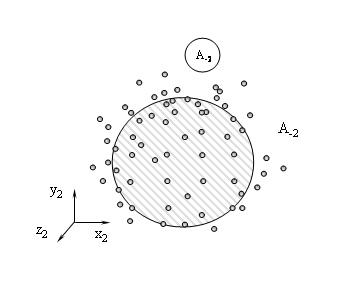
"Elementary" Particles in Space (Aether) Schematic.
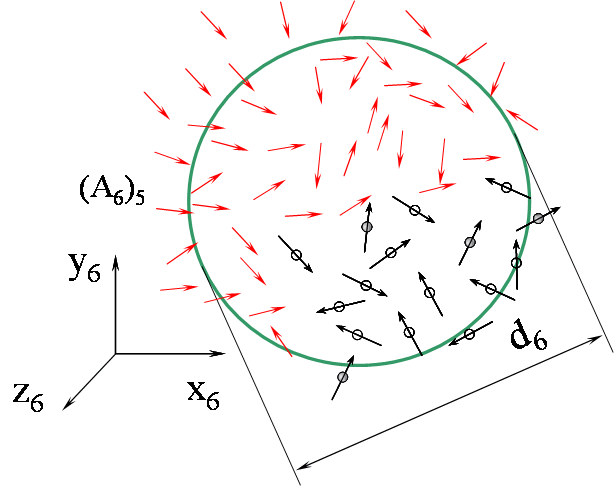
Attention students and professionals - these arrows are not
the physical particles, they are the "point-mass-velocity"
objects. Meanwhile, material points should have no visibility in
physics in opposite to images that
they are drawn in COHP as the dark-black circles.
Points are the invisible and mathematical only objects.
It is the habitual images made by mathematicians as the small
dark-black circles just to designate and to see the location
of Mathematical Invisible Points. But mathematicians never accept
the points as the
different objects than the designation of their location in the
3D Discrete Cartesian coordinate system.
The related mathematical physics' for the "point-particles"
be presented by only arrows for their coordinates and direction
of movement and for the real
volumetric particles and bodies are Different,
quite different.
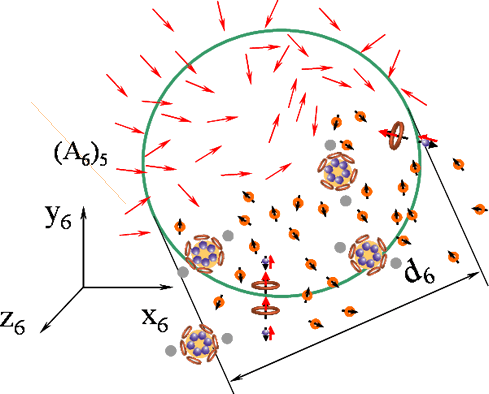
Two presentations of Volume with water molecules in
paramagnetic state at the sub-atomic
Fifth (A5)4 and Sixth (A6)5 zoomed scales distribution of free
electrons, atoms of H, H2O, and ions in the aether in the low
pressure vessel, for example.
The Sub-atomic particles, atoms, and molecules of H2 and water
given not in correct scales in the figure, but to visually
present the real physical model for mathematical modeling that
in COHP absolutely has been screwed since the beginning
of XX century.
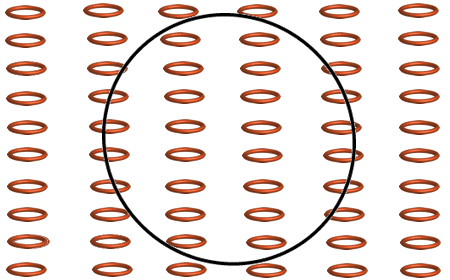
An array of ordered electrons in dynamics. To theorize and model this array
the COHP methods are artificial, so the modeling of particles swarm in particle accelerators
is pretty simplified, while dynamics equations
are incorrect - see our analyses, texts, papers in
relevant chapters-sections in this website
(references below) and elsewhere.
Momentum of the system of particles - again it is according to the textbooks
that teaching university students, is

then is "justifiable"

while the internal forces

 after summation go to zero by Newton's 3rd law(?).
after summation go to zero by Newton's 3rd law(?).
This derivation of the extending use of the 2nd
Newton's law for a System of Particles is considered a cornerstone in
Classical Mechanics.
1) Meanwhile, this is a fake statement of XVIII that continues to our
times. The problem is with the averaging, summation of the particles forces
and actually governing equations. In XVIII century physicists considered no
matter of what are the bounding surfaces of the particles ? And how they
interact together?
Then this is the false argument. As soon as the summation is not going
to be over so pure fit for boundaries, while even if it is and a perfect fit -
then, for transient problem or inhomogeneous spatial problems this 3rd law
does not work.
2) Another more serious disagreement is that as soon
as the summation, but actually the integration over the volume with particles,
in the problem is in need for a bunch of particles (many
particles) then the summation, or averaging should be performed all over the
governing equatons - but not only by its selectively chosen parts and in a
chosen simple summation way of the XVIII.
In this case we need to make the averaging as of the equations

all over the sub-volume with the particles, when the still simplified result will be
as the following.
Considering the Spinning particles we will have in HSP this kind of equation
on the Lower scale that in its simplest form with the electromagnetic force
will be different from the COHP's one above

where

 is the dynamic viscosity of the aether;
is the dynamic viscosity of the aether;
where the first r.h.s. term in the equation which is the stress exchange
with the surrounding intermedium - aether mostly occupying medium, but can be
of other means.
This term never had appeared in the COHP momentum dynamics equations for the
sub-atomic particles. Why not?
Just because there is no intermedium recognized in COHP that is a real actor
in the two phase medium - sub-atomic particles and the Aether or vacuum0.
"Quantum" vacuum of COHP is not a medium, it is the fake substance for filling
gap in properties.
Meanwhile, this term is an outstanding piece in a model for dynamics of
sub-atomic particle in the vacuum0 - in the aether.
Due to the presence of this and similar (will be introduced in models,
publications) terms in the dynamics equations the part of physics - Spinning
("torsion") physics at last obtained the ability to build upon the direct
physical and mathematical models that explain the physical properties and
results in the experiments achieved in the last ~50 years of research.
In the particle dynamic equation written above the electric and magnetic
fields are supposed to be of already found or averaged via the
additional model fields, but
not just simple summation as it is done in Classical Mechanics and Particle
physics of COHP.
Then, the upper scale dynamic equation for electrons (or other sub-atomic
particles) is with the constant mass of electron (or while consider its mass
change negligible for a moment, otherwise mathematics for this equation will
go much more complicated)


and the whole averaged r.h.s. of the equation


where

 is the velocity of the interface surfaces.
is the velocity of the interface surfaces.
All the definitions and mathematics of equations development are given in
[1-4,8-10,12-15].
With the r.h.s. averaged electrodynamics
force field

 (subscript 1 is for electrons) mathematics using the developments for
electrodynamics Lorentz force field term or for the
force defined Galilean formula by Klyushin published in [19-20].
(subscript 1 is for electrons) mathematics using the developments for
electrodynamics Lorentz force field term or for the
force defined Galilean formula by Klyushin published in [19-20].
One can find in these two equations totally the 5 terms (1 in the Lower scale
equation of particle dynamics and 4 terms having the separate physics in the
Upper scale dynamics equation) that have not only the mathematical
significance, but truly representative of the devoted physical phenomena of
interaction with the aether - that means and with the other particles.
This part of the model for sub-atomic particles spinning in
the aether is missing in COHP either Lower or somehow averaged Upper scale
models.
It is worth to mention here, that this is
completely impossible to deliver, analyze, provide some treatments, and
simulation in the one scale COHP collective dynamics of particles cloud.
That means the summation-averaging in COHP Classical Mechanics cannot
correctly be performed in such a simple method as it is taught to students
for more than 200 years in these equations

with the simple final equation
known to all student generations

This was more or less justified up to ~1980s, but no later.
=====================================================
Continuum Mechanics Particles Singular and Collective
Dynamics Models as for the Centers of Mass in COHP and HSP
Having almost the same arguments on modeling in the Classical Mechanics
momentum of the system of particles - again it is according to textbooks that
teaching school and university students,

then

while the internal forces

 after summation are set to zero by Newton's 3rd law(?).
after summation are set to zero by Newton's 3rd law(?).
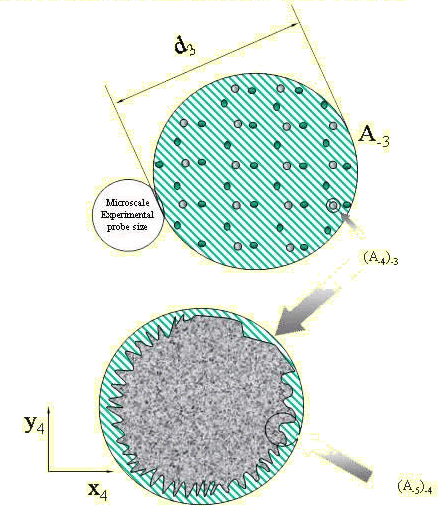
Three scales for 2 Arrays of Continuum Inhomogeneous Particles
in the Fluid and Aether Media.
Considering the Spinning Continuum Mechanics particles we will have in HSP the
equation that will be different again from the HSP's one we derived above

where

 is the dynamic viscosity of the continuum model
fluid around the particle; where we dropped the surface stress
influence caused by the aether; where the averaged fields
is the dynamic viscosity of the continuum model
fluid around the particle; where we dropped the surface stress
influence caused by the aether; where the averaged fields

 and
and

 will be different from the same kind of fields in the aether;
will be different from the same kind of fields in the aether;
where the first r.h.s. term in the equation which is the stress exchange
with the surrounding intermedium - gaseous or fluid occupying medium

 .
.
Further averaged will be the equation
(
 )
on the Upper scale consideration (we do usually are interested in the
Upper scale properties, characteristics, etc.)
)
on the Upper scale consideration (we do usually are interested in the
Upper scale properties, characteristics, etc.)


and the whole averaged r.h.s. of the equation (subscript

 for continuum)
for continuum)


where it is almost the same equation as (2) while meanings and values of
variables, parameters, and electrodynamic forces are different.
-----------------------------------------------
Continuum Mechanics Volumetric Particles Singular
and Collective Dynamics Models in COHP and HSP
Next is the modeling of the momentum equation at the Lower scale for a
continuum particle interior as of the some working volume with a medium of
some substance of like a phase (1)

within the particle's phase (1)
as the fluid or "fluid" like
medium
 which is to be the phase (1)
of the polyphase medium that is in an immediate interaction, contact with the
external fluid (gaseous) or aether (phase 0)
first of all, where
which is to be the phase (1)
of the polyphase medium that is in an immediate interaction, contact with the
external fluid (gaseous) or aether (phase 0)
first of all, where

 is
the dynamic viscosity coefficient (parameter) in the particle's
(droplet) phase.
is
the dynamic viscosity coefficient (parameter) in the particle's
(droplet) phase.
While the Upper scale Continuum Mechanics momentum equation for the averaged
particle's phase (1) is the following [1-4,12-15,19-20] (it is the great amount of
knowledge in HSP and the 2nd Physics reflected upon theories in these references,
still mostly it's not taught and not reaching students in the
universities and senior school classes)




where

 is the velocity at the interface surfaces, and this is the real point velocity
function in the problem. Meaning the surface location and its physical
properties as the speed, electric and magnetic fields explain and participate
in the interaction functions.
is the velocity at the interface surfaces, and this is the real point velocity
function in the problem. Meaning the surface location and its physical
properties as the speed, electric and magnetic fields explain and participate
in the interaction functions.
All the definitions and mathematics of equations development are given in
[1-4,8-10,12-15], other publications on continuum Mechanics
HSP.
Totally the 7 new term-functions have come
out here in the HSP models for the two-phase continuum particles and external
fluid media counting only on the droplet's phase side process'.
Well - in this area of physics we write and discuss for decades the stubborn
deeds of orthodox university physicists, professors that cannot learn from the
facts. Either incapable to learn, no enough talents, or want to be
"inventors" of the wheel
again?
See the most advanced chapters in COHP
on polyphase physics physical and mathematical modeling that are not correct
and present embarrassments to physics and to
the authors of this "science" -
It is worth to mention again and again - that the US government agencies
like NSF and DOE mainly, others participating for DECADES
while doing the polyphase programs, with billions dollars spent
since ~1970, on my memory
in 90s and 2000s uninterrupted effort was concerned - and no good
physical theory they COULD create.
Notwithstanding, that the physical and mathematical apparatus
has been in the development since the 1970s!
Strange people. Unqualified.
The Second (2nd) Physics Anyway Should prevail.
In this concern it's obvious that the leading physicists have been teaching
students on false even the Classical Mechanics - the Cornerstone of the
cornerstones.
Instead of these separate particle equations summation as it has been done in
Classical Mechanics of COHP

with this simple, but wrong final equation known to all students
in technical and physical professions

lecturers should be at least using the following equation for
the Upper scale collective dynamics of continuum fluid "like" system of
particles of phase (1)


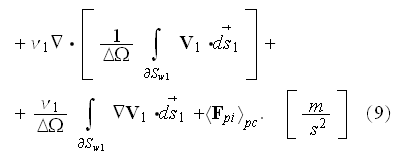
We would remind that this section better be understood
by the graduate students.
CONCLUSION
There are known today a few other particle momentum
equations even in Quantum physics (most of them) with like additional terms
for the "forces" in the right hand side of the equations. Those "forces" are
the ad-hoc obtained "forces" [12-15,18,21-22].
Thus, can be pointed out the forms of Takabayasi and Shipov with the
additional terms, others as well. The well mathematically developed
imaginable quantum mathematical exercises continue up to now in
this field of quantum "particles" mathematical physics. In all of them
the "particle" is the PMCS object while there is no intermedium
between the "particles."
Authors are stupidly confident on the false writings as,
for example, -
"the many-particle microscopic Schrodinger equation" and
"many-particle quantum hydrodynamics MQHD approach" and etc. Authors mean
that they can develop and use the kind of "averaged" PMCS objects
"the many-particle..."
equations and state that this is the hydrodynamic presentation
of a "spinning fluid" ?
Come on - COHP physicists cannot do "the many-particle ..ANY... equation"
- because in COHP there is no correct methods and mathematical theory
for obtaining these "the many-particle ....equations"! They pretend that
they don't know about this. But workers specifically don't use the only
correct and everywhere used in physics term "averaged" - just because
they do know that "the many-particle..." equations developed in quantum
physics, plasma physics by followers of E.Madelung's idea are incorrect,
defective.
We had written a few manuscripts on this in [7-10,13,18-27], see also the direct
links below.
E.Madelung in 1920s (1926) did not know how to do this - and the 90 years
after him all the followers - Takabayasi and Shipov, Bohm and co-authors,
others in ~(1970-2015) had no idea how to do this correctly.
Computational schemes on the hydrodynamic interpretation of QM that have
been presented on the scene a few last decades are almost worthless
due to the unphysical foundation of the physical and mathematical
statements for dynamics of sub-atomic particles either a singular
one or of the assembly, array, cloud of particles.
All these equations are based on the false premises of collective
interaction - none of interaction in reality, but just proclaimed,
and Homogeneous averaging - actually none of averaging,
of the point-mass-charge-spin objects (named particles) in
some imaginable, not defined, volume in the space [7-10,13,18-27].
That means the formulation and the additional terms in these COH physics
derived equations as in and for Homogeneous media are of not a physical sense.
And actually the momentum and other similar equations are of
the ad-hoc construction nature.
In numerous chapters and papers on HSP-VAT in this website and elsewhere there
are plentiful problems formulated and solved, and not only for a momentum
dynamics, with the additional r.h.s. Hierarchical Scaled (HS) physics
described terms. Specifically for the three kind of problems in HS
Classical Mechanics and Particle Physics these terms are depicted in [26,28].
It is the great part in Quantum physics, plasma physics devoted to these "pseudo-science"
dynamics equations following the devised invisible Point-Mass-Charge-Spin (PMCS)
"particles" [12-15,17-28].
It is obvious now what kind of omissions and wrong parts,
equations are allowed to exist in COHP universities Classical Mechanics
only to be consistent with the great developments of XVIII century
in Classical Mechanics and in XX century in Quantum Physics.
This teaching just of the university Homogeneous Classical Mechanics
and PMCS "particles" Quantum Physics prohibits the big advancements in all
related physical fields - see, among other faults of COHP in the
preceding volumes of Heterogeneous Hierarchical physics for the
sub-atomic and atomic scales -
then on the "Atomic and Sub-atomic Scale Description....," section
and on the Ht MHL (Maxwell-Heaviside-Lorentz) Electrodynamics
with the following content on Galilean Polyscale Electrodynamics
with stated in the introductory -
and
and in
and in
and in
References
1. Travkin, V.S., Fundamentals of Hierarchical Scaled Physics (HSP-VAT).
Description of Transport and Phenomena in
Heterogeneous and Scaled Media
(2003)
2. Travkin, V.S. and Catton, I., Transport Phenomena
in Heterogeneous Media Based on Volume Averaging Theory,
in Advances in Heat Transfer, Vol. 34,
Academic Press, New York, pp. 1-144, (2001)
3. Travkin, V.S., Continuum Mechanics of Heterogeneous
(Ht) Media; Elasticity, Plasticity,
(2005)
4. Travkin, V.S. and Catton, I., "Porous Media
Transport Descriptions - Non-Local, Linear and Nonlinear Against
Effective Thermal/Fluid Properties," in Advances in Colloid
and Interface Science, Vol. 76-77, pp. 389-443, (1998)
5. Travkin, V.S., "Why is it Different from
Homogeneous and other Theories and Methods of Heterogeneous Media
Mechanics/(other Sciences) Description?"
(2002)
6. Travkin, V.S., "Reductionism and/versus Holism
in Physics and Biology - are Both Defective Concepts without
Scaleportation,"
(2004)
7. Travkin, V.S., "Solid State Plasma Models,"
(2006)
8. Travkin, V.S., What's Wrong with the Pseudo-Averaging Used in
Textbooks on Atomic Physics and Electrodynamics for Maxwell-Heaviside-Lorentz
Electromagnetism Equations,
(2009)
9. Travkin, V.S., Incompatibility of Maxwell-Lorentz Electrodynamics
Equations at Atomic and Continuum Scales,
(2009)
10. Travkin, V.S., Electrodynamics 2 - Elements 3P (Polyphase-Polyscale-Polyphysics),
(2013)
11. Bobrov, A.V.,
"The Interaction of Spin Fields - Fifth Fundamental
Interaction. Pt.2," International Journal of Unconventional
Science, Vol. 1, No.2, pp. 8-22, (2013)
also at: http://www.unconv-science.org/n2/bobrov/; retrieved 08/29/2014
12. Travkin, V.S. and Bolotina, N.N., "The Classical and Sub-Atomic
Physics are the Same Physics,"
,
(2013)
13. Travkin, V.S., Particle Physics - Heterogeneous
Polyscale Collectively Interactive,
(2011)
14. Travkin, V.S., Particle Physics (Particle
Physics 2). Fundamentals,
(2013)
15. Travkin, V.S., Nuclear Physics Structured.
Introduction,
(2006-2013)
16. Travkin, V.S., Experimental Science in Heterogeneous Media,
(2005)
17. Travkin, V.S., Statistical Mechanics
Homogeneous for Point Particles. What Objects it Articulates?
(2014)
18. Travkin, V.S., Solid State Polyscale Physics.
Fundamentals,
(2014)
19. Travkin, V.S.,
"Two-Scale Three-Phase Regular and Irregular Shape Charged Particles (Electrons, Photons) Movement in MHL Electromagnetic Fields in a Vacuum0 (Aether),"
(2013)
20. Travkin, V.S. and Bolotina, N.N.,
"Two-Scale Two-Phase Formation of Charged 3D Continuum Particles - Sphere and Cube From Electrons in a Vacuum0 (Aether). An Example of Scaleportation of Charge from the Sub-Atomic to Continuum Charged Particles, Conventional MD Cannot be Applied,"
(2013)
21. Travkin, V.S., Atomic and Subatomic Physics 2 - Elements 3P,
(2003-2015)
22. Travkin, V.S., "Classical Mechanics Attempts for Description
of Atomic Physics (ClM One-scale One-phase Homogeneous
Atomic Physics - ClMO2HAP) Phenomena,"
(2014)
23. Gordienko, Y.G. and Travkin, V.S., "Transport Properties of Point-Like Objects in Multi-Scale Heterogeneous Substructure,"
(2003)
24. Travkin, V.S., "Crystalline Medium Defects and Micro-Heterogeneous Solid State Plasma VAT Equations,"
(2004)
25. Travkin, V.S., "Bridging atomic and macroscopic scales for materials, process, and device design. US-Russian Workshop on Software Development (SWN2003),"
(2003)
26. Travkin, V.S., "The Major Forces Have Been Missing
From Governing Equations for Dynamics of Sub-atomic and
Continuum Particles, Bodies in XVIII - XX,"
(2014)
27. Travkin, V.S., "Top-Down and Bottom-Up
Hierarchical Processes in the E-Cat Nuclear Reactor. Physics 2,"
(2012-2013)
28. Travkin, V.S., Heterogeneous Classical Mechanics
(HtCM) -
(3DD) - Physics 2 (3P). Introduction,
(2016)
*********************************************************************
Any information displayed here is the propriatary information
in the area of
"What Classical Mechanics of XVIII Provided in XX Has Done Wrong to the
Base of Mechanical Science Including the Classical Mechanics of
Continuum Particles and Conventional Orthodox Homogeneous Particle Physics".
This is not the well known
problem, but should be well known - still can not be resolved within the
Homogeneous One-Scale
General physics, Spinning physics, nuclear, particle and atomic physics,
electromagnetism,
Gravidynamics and astrophysics.

UNDER CONTINUAL DEVELOPMENT



 )
movement the momentum equation should be based
for bunch of particles on the following forces:
if for
)
movement the momentum equation should be based
for bunch of particles on the following forces:
if for

 -th
particle let
-th
particle let

 be the mass; let
be the mass; let

 be the position vector; and
be the position vector; and

 is the momentum;
is the momentum;

 is the angular momentum;
is the angular momentum;

 is the moment of force;
is the moment of force;

















































